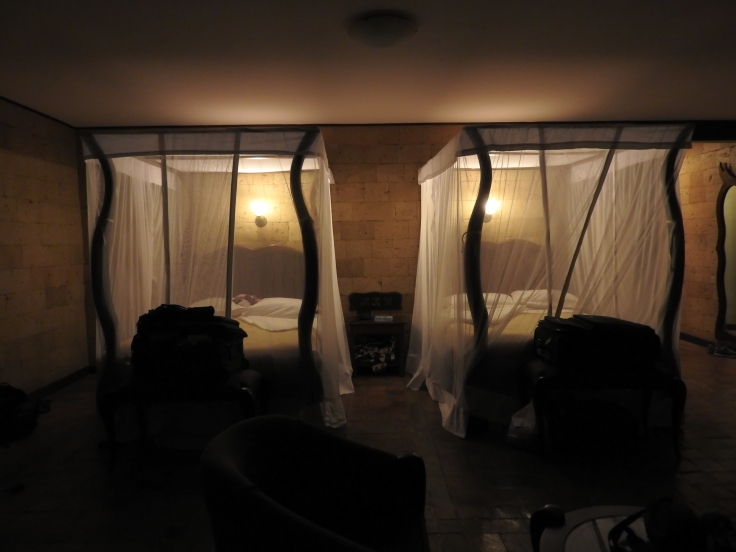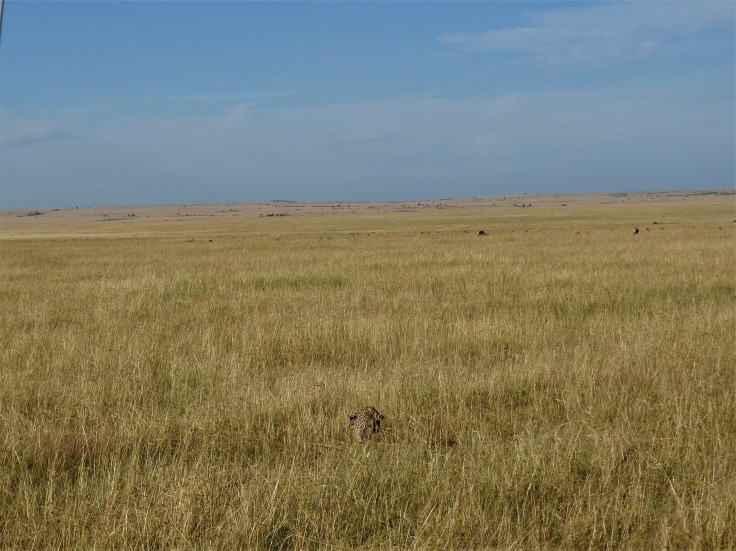February 27th
The wall sconces cast a dim light in our room on this early morning travel day. We linger in our beds chatting about what we have experienced. Half the trip is completed and we are feeling a sense mourning as the end of the trip draws closer. Everyone in our groups has said Masai Mara is the highlight, but we can’t imagine how it can get better.

We go through the ritual of taking turns washing up and dressing and when the zipper pulls closed on the last of our bags, we walk the room, double checking to make sure neither of us has left something behind.
Monique shuts the door behind us and the clacking of the wheels rolling on the stone walkway seems loud against the quiet morning. The sun is just coming up and already the air is close with humidity.


It is a five-hour drive from Lake Nakuru national park to Lower Masai Mara national reserve. A long drive but I think of it as a five-hour course in anthropology.
We pass through an area where some of the world’s best coffee and tea are grown. All the jeeps stop on the side of the road and immediately several men thrust their products up to the windows of the jeep. I know my sister and brother-in-law will love some, so I roll down the window and the dickering begins. I am quoted $400 shillings a bag ($5). I come back with $300 and he says $350 ($4 Cdn) and we shake on the price. I buy one bag of coffee and one of tea, and hope I helped him get a little closer to his daily sale quota.
Some villages we pass have no electricity poles. Eric tells us,where there is no electricity, everything is run on generators and boilers. Which means refrigeration is almost non-existent.
“We would have to drink warm beer, Mo,” I say. We have a chuckle but I am aware of the sensitivity of that matter since our visit to Kibera. It is not uncommon for locals to walk many kilometers to market to make their daily food purchases or sell their goods and have to return home the same distance.

Within the populated towns the roads are paved, but once we leave the centers, the pavement gets spotty. We drive in a convoy of four vehicles. Some roads are so rough I am fearful the tires will get a puncture. The fog of dust rising off the wheels penetrates the jeep’s interior even with the windows rolled up. My smile lines are creased with grit.
It is hard to believe the stark contrast in the landscape within a few hours’ drive This one community was basically plunked in the middle of a rock field. How do these people scrape out a living here, where there is no soil? 
We are told we are stopping for fuel and supplies; it will be our last opportunity to get any personal items we require. Masai Mara national reserve is remote.
We all file from our individual jeeps and hit the only bank for some currency. Then Monique and I head for the supermarket. We asked Eric to accompany us for interpretation and to help with the carry-out. We make our selections, dole out our shillings and walk back to the jeep with our hands full of six-packs of tall-can Tusker beers — a standard Canadian two-four. Shall we raise the maple leaf flag now?
The amount of beer we are toting seems to cause a stir among our tour partners and a few gentlemen in the parking lot standing outside their cabs. However, the math was simple. One pack for Eric, for putting up with us, and eighteen beers for Monique and me to share over the next six days. Not nearly enough according to Cape Breton standards, but more than enough to raise a few eyebrows with our fellow tour companions. We would have gone back for more if no one was looking.

Forward we go. A sprinkling of hartebeest and gazelles draw my attention but we have seen so many they appear like dogs. Just endless grassy fields then we come across the rarely seen species: Man sitting in a chair in a field. It sounds like a painting that might hang in the Oppenheimer museum. Monique asks Eric, “What is he doing way out here?” Eric laughs and replies. “Hakuna Matata, he is just having a seat.”
A truck filled with furniture passes us on the left. Your standard move: mattress, bureau, chair, and a man leaning on top of the belongings with a sheep on a tether. I will let you puzzle that one out.

Almost there.
I observe scenes that could have happened 2000 years ago. Playing out in heartbeat with our modern world.
Shepherds still tend sheep; they carry a stick and shoo their charges forward. Donkeys pulling carts loaded with goods for market, along the road beside cars. Masai warriors dressed in red tribal dress, speaking into cellphones. Eric tells us his mothers’ family are Masai, he was raised with their traditions. I think, what a hard culture to hold onto in this changing world.

We are here
I lose track of time and distance. The grassy plains stretch out in front of us and appear to have no end. With no buildings to set your focus on, the open savanna it is dizzying and monotonous. Swaths of long grass waving in the breeze, hiding predators and attracting prey. We have arrived at the Lower Masai Mara.

It is too early in the season to see the wildebeest migration. They are still down in the Serengeti birthing grounds across the border in Tanzania. But “abundance” and
“plentiful” are the words that come to mind and I know why they make the dangerous journey to this land. While we’ve missed the world’s largest concentration of mammals, this is also the place of big cats and our first encounter with cheetah is yet to come.

Please join me for my continuation of What Kenya did to me-What Kenya did to Me: Lower Masai Mara Part 6
Happy Travels from Maritime Mac.
If you missed any of the previous post here they are;
What Kenya Did To Me,- Kibera Part 1
What Kenya Did to Me: Samburu Part 2
What Kenya did to me: Ol Pejeta, Part 3
What Kenya did to me-Lake Nakuru Part 4

Contribute
If you like this content you can tip me to show your appreciation. and ensure the continuation of this blog
C$2.00




Another great trip, Kelly. We missed Masai Mara, having to cut across Kenya farther south on our way to Ngorongoro and the Serengeti. Looking forward to your adventure there. –Curt
LikeLike
Thank you. I appreciate your comments.
LikeLiked by 1 person
Fabulous shots! What a great experience.
LikeLike
Thank you Ladyfi. I will be sure to check out your post regularly cheers
LikeLike
How marvelous! Your writing makes me miss home. I love Nakuru and the Rift Valley. I’m yet to travel to Mara but hope to on my next trip home. #tembeakenya
LikeLike
Oh what a wonderful place to call home. cheers and I will be sure to check your blog regularly. have a great weekend.
LikeLike
wonderful shots. how lucky you are to have been able to go there and experience that! 🙂
LikeLike
I am very grateful I had the opportunity. It was trip of life time
LikeLike
This post made me so excited for my trip to Africa in August! I’ll be in Tanzania and can’t wait.
LikeLike
Lucky you, I have been obsessed with returning, I will look forward to your posts
LikeLike